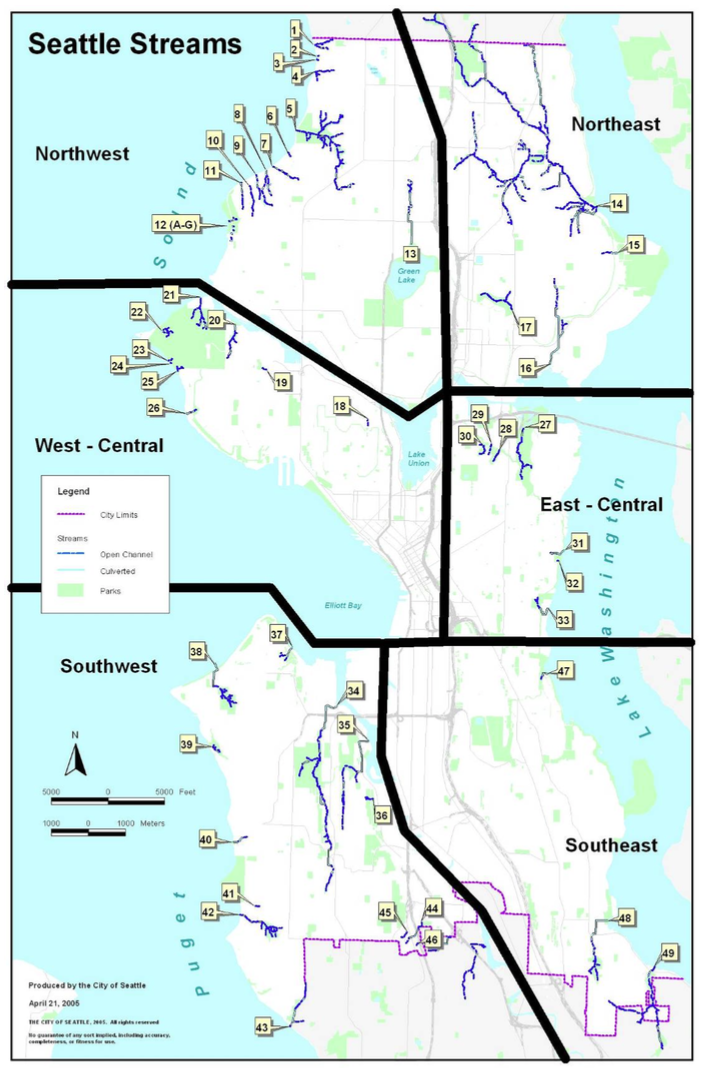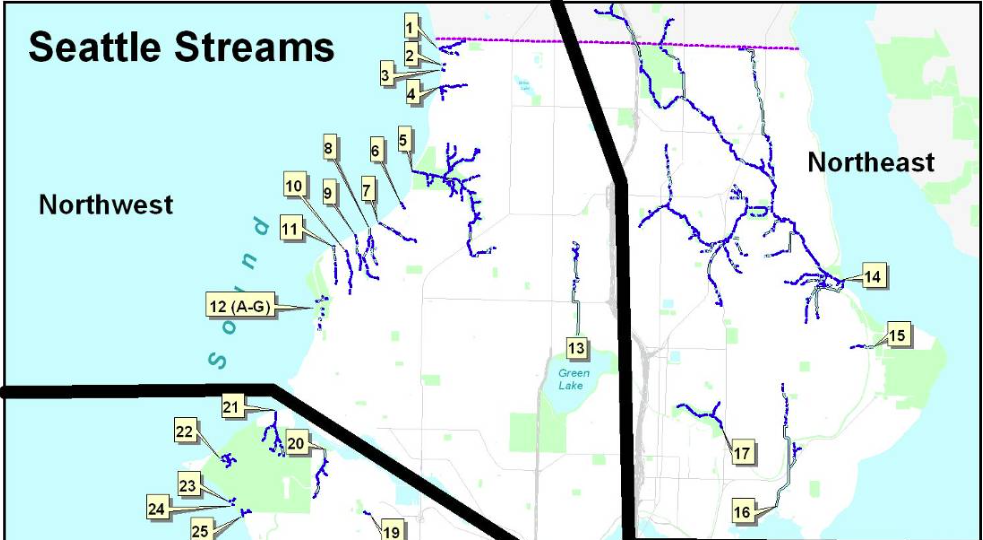Part 1 of a three part posting about Seattle Streams.
Part 2 of the post.
Part 3 of the post.
Look at early General Land Office maps of Seattle from the 1850s and you will find dozens upon dozens of streams. Look at a modern map of Seattle and you will find very few streams, yet at least 50 named streams wind their way across the landscape. (I can only wonder at how many of the original streams never made it onto any map and how many are now covered by pavement.)
Over the past year or so, I tried to track down the names and locations of the streams, along with whatever I could locate about the origin of those names. My next few blog posts will detail the information that I found. If you do find errors, please let me know. Also let me know if I omitted any streams.
Unfortunately, there is no good map showing all of the streams. If anyone wants to produce one, I would be interested in helping out. The map that accompanies the names is from a US Fish and Wildlife Service Report. Distribution and Habitat Use of Fish in Seattle’s Streams Final Report, 2005 and 2006, by Roger A. Tabor, Daniel W. Lantz, and Scott T. Sanders. It was published in January 2010.
I will include the full map on the first post with close ups scattered throughout. The numbers on the names refer to numbers on the map. Creeks without numbers are not on the map but do or did exist. Click on the maps for a larger version.

Northwest Streams
4. Broadview – West side of north end of city – Apparently named for the neighborhood where it flows.
5. Piper’s – Flows through Carkeek Park – Named for early candy manufacturer Andrew William Piper, who lived on the land now preserved by the park. Piper owned the orchard in the park. Creek shown on 1909 USGS Topo Map of Seattle. (Enjoying Seattle Parks, by Brandt Morgan)
Mohlendorph – Tributary of Piper’s Creek – Named in honor of Ted Mohlendorph, who died in 1991. He was a passionate advocate for Seattle streams and worked at helping to preserve spawning runs at Piper’s Creek. (Seattle Times, Obituary, August 19, 1991)
5. Venema – Tributary of Piper’s Creek – Harry G. Venema and his family moved into the area in 1919. Born in Michigan, he had arrived in Seattle in 1908 and worked at Peoples National Bank and Seattle-First National Bank. Sons Jerry and Walt saw what was reportedly the last spawning salmon in Piper’s Creek in 1927. (Seattle Times, August 14, 2004)
13. Licton Springs – Historically flowed into Green Lake – Licton Springs is the only neighborhood with a native name that gives a clue to what the area may have looked like prior to the arrival of pioneers. The name is a corruption of the Lushootseed word liq’ted (LEEK-tuhd), which means “red” or “paint.” It refers to the iron oxides that still precipitate from springs bubbling out of the ground.
Northeast Streams
Lyon – Shown on 1897 USGS Topo Map Seattle Sheet – Not technically in Seattle. I included it because it is shown on this early map. A June 4, 1911, article in the Seattle Times described it as the “best trout stream in Seattle.” May also show up as Lyons Creek.
14. Matthews – Tributary of Thornton Creek – John G. Matthews arrived in Seattle in 1910. He was born in Kentucky, where he was a bank president and coal mine owner. In Seattle, he practiced law and invested in timber and coal. In 1951, the city purchased the land that became the park named for the family. (Valarie Bunn’s web site, wedgwoodinseattlehistory.com)
14. Littles – Tributary of Thornton Creek – The Little family settled near the modern Paramount Park in the early 1900s. They ran a sawmill and mined the peat in the ravine. Some early Park plans refer to a Jones Creek, which may have been a tributary of Littles. (Thornton Creek Watershed Characterization Report and Sherwood Files, Seattle Parks Department)
14. Willow – Tributary of Thornton Creek – Named by Martha Nishitani for a willow tree growing along the creek. (Correspondence with Valarie Bunn.)
14. Victory – Named for the Victory Heights neighborhood, which was named in 1920 for what we now call Lake City Way. The road was called Victory Way, from a little after WW I to about 1930. (Victory Heights Blog and Shoreline Historical Museum)
14. Mock – Tributary of Thornton Creek – The Mock family owned property on NE 97th Street, east of 35th Ave. NE. According to an interview with one of the daughters by local historian Valarie Bunn, one of her brothers worked for a weed-spraying company and used to come home and discharge the rest of his chemicals into the ravine where the creek flows. (Correspondence with Valarie Bunn.)
14. Little Brook – Tributary of Thornton Creek – Unknown origin but seems likely to have something to do with size but could be a family name.
14. Kramer – Tributary of Thornton Creek, entering South Branch, at 30th Ave. NE and NE 107th St. – Unknown origin.
14. Thornton – Creek with largest drainage of any in Seattle – John Thornton purchased the headwaters of what would become his eponymous creek in October 1, 1885. Four years later, the name Thornton Creek appeared on an 1889 land claims map, which makes it the earliest creek name to appear on a map. Born in Indiana, Thornton arrived in Steilacoom in 1850 and lived in the Dungeness/Port Townsend region. He never lived at, and may never have seen, his property in Seattle. South branch formerly known as Maple Leaf Creek. (Valarie Bunn’s web site, wedgwoodinseattlehistory.com)
Fisher – Thornton creek was also known by this name early in the 20th century. Unknown who Fisher was or whether it refers to an activity. Also could be Fischer, which seems more likely.
Evergreen – Tributary of Thornton Creek – Now known as Meridian, because community petitioned to change it.
Sacagawea – Tributary of Thornton Creek, entering South Branch, just west of Lake City Way
Hamlin – Tributary of Thornton Creek – The Hamlin family owned quite a bit of property in what is now Shoreline, though they did not homestead the land that became Hamlin Park. At some point, Seattle Trust and Savings acquired that property and donated it to the city. It is unknown when the name became associated with the creek; Vicki Stiles at the Shoreline Historical Society proposes that it was named when Hamlin was platting the land, at least as early as 1907. (Correspondence with Vicki Stiles, Shoreline Historical Society.)
15. Inverness – Flows off east side of View Ridge, overlooking Magnuson Park – Real estate man Jay Roberts gave the name Inverness Drive to the neighborhood he started to develop in 1954. The name was meant to convey the idea of the castle-like estates Roberts planned to build. (Valarie Bunn’s web site, wedgwoodinseattlehistory.com)
16. Yesler – Flows into Union Bay near Center for Urban Horticulture – In the late 1880s, Henry Yesler moved his sawmill operations here to prosper from the great trees surrounding the north side of the lake; all of the forests closer to downtown had already been logged. The lumber was put on rail cars and taken back to Seattle via a train spur. Yesler arrived in Seattle in 1852.
17. Ravenna – Historic main drainage of Green Lake. – W. W. Beck bought the land that would become Ravenna Park in 1887. He named it to honor the Italian coastal city “that was famous for its pine trees, where poets, warriors, and statesmen once strolled in a state of euphoria similar to his own.” Name appears in October 1906 in City of Seattle Comptroller File 30782 for a petition for a foot bridge across the creek. (Seattle Parks Department web site on Ravenna Park)

Hi David,
Not sure how this Reply function works, as there were no headers displayed on the reply fields. Anyhow, my wife and I live in Broadview, more or less spitting distance from what – I presume to be – Broadview Creek (we live on 7th Ave NW about a block north of 132nd Street. As a smitten fisherman, I’ve been intractably obsessed with the local creeks and dribbles, especially the ones that discharge into Puget Sound. For a number of years I fly-fished local beaches, primarily focusing on the little (frequently semi-seasonal) runs into the salt (and regardless of what the fish and wildlife folks say, there is at least some colonization of even the smallest creeks, at least seasonally and at least for short distances upstream. In any case if you’re interested in poking around Broadview Creek, I’d be happy to accompany you. BTW, according to one of the original homeowners on my block, this creek probably originally drained Bitter Lake. Not sure what the subsequent history was, but there was a large amusement park there called Playland (some documentation of this at the community center, I believe) and it’s possible that the disruption of the outflow may be related to that development.
Wes Neuenschwander
Hey Wes, what about stream number 1? Its shown on your map, but there is no info about it in the text.
Broadview Creek is actually more known and listed as Spring Creek. Growing up along it in my early years (we were on 12th), my folks said the guy the bought their house from said it was Whiskey Creek for activities during the prohibition era.
Coll Thrush in Native Seattle shows the creek mouth as a seasonal fish camp for the Duwamish.
Thanks!